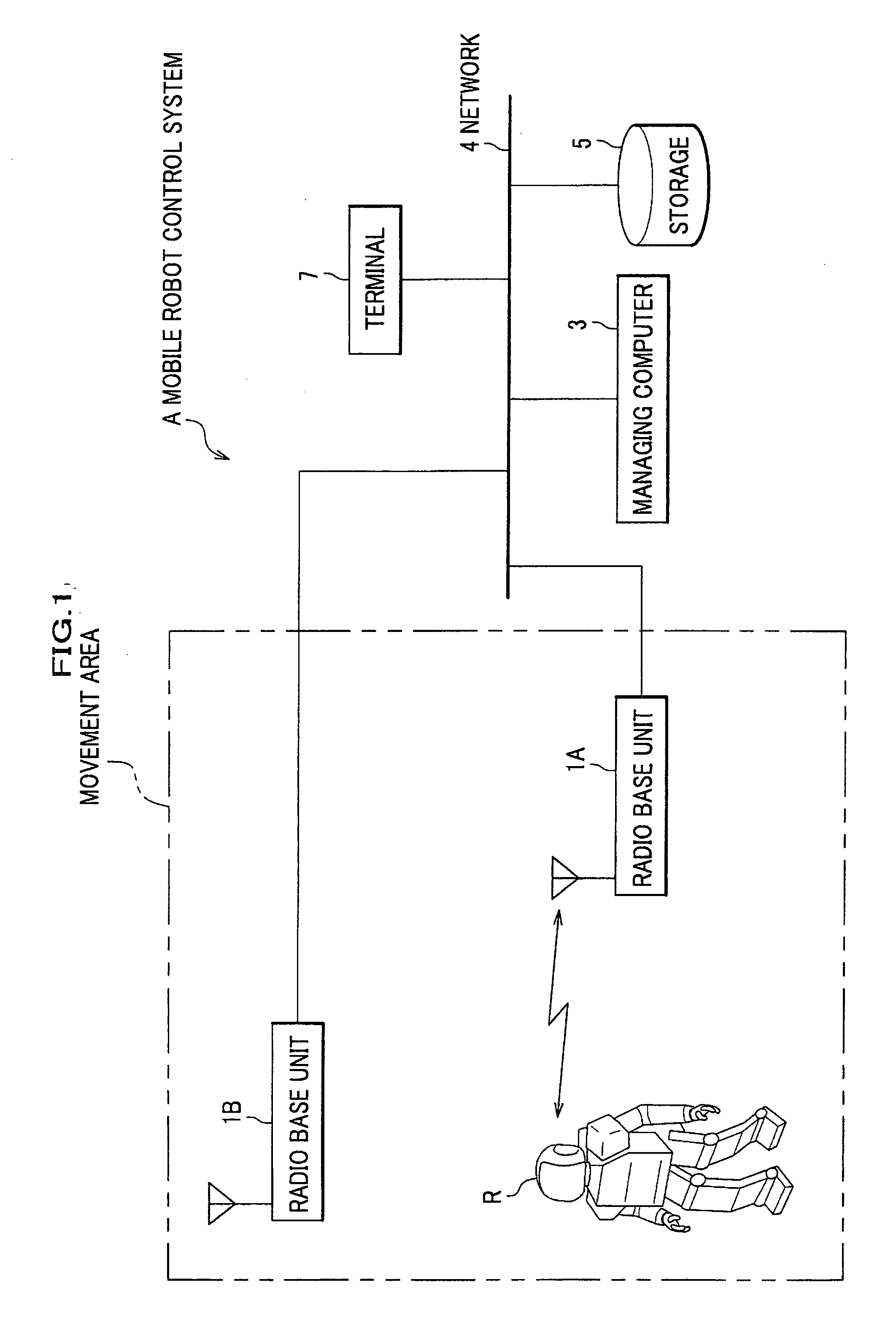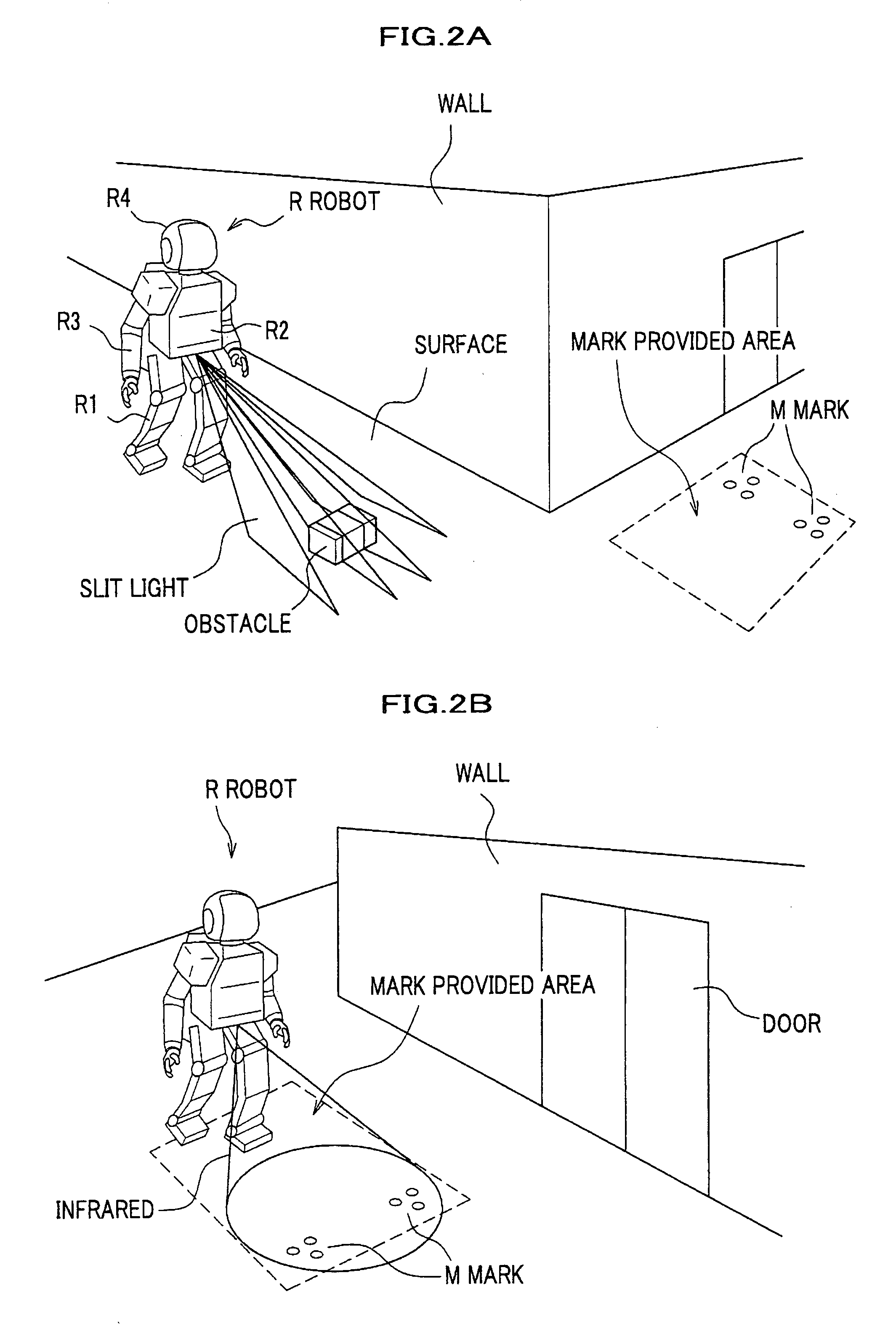Mobile robot and controller for same
a technology of mobile robots and controllers, applied in the direction of process and machine control, manufacturing tools, instruments, etc., can solve the problems of mobile robots not being able to remotely control by radio, mobile robots not being able to return to a communication-feasible area, etc., to achieve the effect of reducing movement speed, preventing communication from happening, and ensuring the time required
- Summary
- Abstract
- Description
- Claims
- Application Information
AI Technical Summary
Benefits of technology
Problems solved by technology
Method used
Image
Examples
first embodiment
Configuration of Robot
[0208]FIG. 5 is a block diagram showing the configuration of a robot according to a first embodiment.
[0209] As shown in FIG. 5, the robot R includes cameras C, a speaker S, a microphone MC, an image processor 110, a voice processor 120, a main controller 139, an autonomous movement controller 148, a radio communication unit 160, and a surroundings-state detector 170 as well as the legs R1, the torso R2, the arms R3, and the head R4.
[0210] The robot R further includes a gyro sensor SR1 for detecting directions and / or a GPS (Global Positioning System) receiver SR2 for detecting coordinates as a self-position detecting unit for detecting its own position.
[Camera]
[0211] The cameras (image pickup units) C are for reading in images in the form of digital data and are embodied by, for example, color CCD (Charge Coupled Device) cameras. The cameras C are arranged laterally in parallel, and the images picked up are output to the image processor 110. The cameras C, ...
second embodiment
[0460] Next, a mobile robot of a second embodiment will be described with reference to the drawings. The basic structure of the mobile robot of the second embodiment is the same as that of the mobile robot of the first embodiment, and differences from the latter will be mainly described.
[0461] In description, the same elements are indicated by the same reference numerals with duplicate description being omitted.
[0462] First, a mobile robot control system A of the second embodiment will be described.
[0463] As shown in FIG. 1, the mobile robot control system A comprises a mobile robot R (hereinafter a “robot” for short) provided in a movement area where to execute a task; a radio base unit (radio base station) 1 (1A, 1B) linked to the robot R by radio communication; a managing computer 3 connected to the radio base unit 1 via a network 4; and a storage 5 and a terminal 7 connected to the managing computer 3 via the network 4. The numbers of mobile robo...
third embodiment
[0641] Next, a mobile robot of a third embodiment will be described with reference to the drawings. The basic structure of the mobile robot of the third embodiment is the same as that of the mobile robots of the first and second embodiments, and differences from the latter will be mainly described.
[0642] First, a mobile robot control system of the third embodiment will be described. FIG. 39A is a block diagram of the mobile robot control system of the embodiment of the present invention.
[0643] As shown in FIG. 1 and FIG. 39A, the mobile robot control system A comprises a mobile robot R provided in a movement area where to execute a task; a radio base unit 1 linked to the mobile robot R by radio communication; a managing computer 3, a storage 5, and a terminal 7 connected to the radio base unit 1 via a network 4. The numbers of mobile robots R and radio base units 1 provided in a movement area where to execute a task are not limited to this embodiment....
PUM
 Login to View More
Login to View More Abstract
Description
Claims
Application Information
 Login to View More
Login to View More - R&D
- Intellectual Property
- Life Sciences
- Materials
- Tech Scout
- Unparalleled Data Quality
- Higher Quality Content
- 60% Fewer Hallucinations
Browse by: Latest US Patents, China's latest patents, Technical Efficacy Thesaurus, Application Domain, Technology Topic, Popular Technical Reports.
© 2025 PatSnap. All rights reserved.Legal|Privacy policy|Modern Slavery Act Transparency Statement|Sitemap|About US| Contact US: help@patsnap.com



